In today’s technology world, the Software Development Life Cycle (SDLC) helps organizations by enabling innovative solutions in the software development domain. It plays the role of an important framework offering a more structured way to develop optimized software.
Moreover, SDLC is a cost-effective technique that helps developers design and develop high-quality products within a specified time frame.
The article below covers what SDLC is, its various phases (or stages), various models, and other useful information.
What is the Software Development Life Cycle?
The SDLC is a systematic process used by software developers to design and develop high-quality software that meets customers’ requirements.
It is a methodology that breaks down the development process into a series of steps. Thus this systematic framework increases the process visibility for all the stakeholders, leading to enhanced satisfaction among them.
What is the need for SDLC?
A systematic life cycle model needs to be in place for software development. This kind of model helps the development team members understand the proper sequence of the tasks to be performed and execute the process in a disciplined manner.
With the implementation of the SDLC model, chaos and project failures can be avoided. It determines the criteria for entry and exit for every phase of the process.
And, if there isn’t any such systematic model, it becomes difficult for project managers to monitor the project’s progress.
What are the Software Development Life Cycle Phases?
There are 6 phases or stages in the SDLC model and they all are described below:
Phase 1: Planning & Requirement Analysis
The first stage of the SDLC model is the requirement analysis which requires the involvement of the team’s senior members. These members collect the required inputs from domain experts and stakeholders.
Once the input data, such as what needs to be developed, who the product’s end user will be, what the objective is, etc., are gathered and well understood, an SRS document is created.
The developers must follow the SRS (or Software Requirement Specification) document. And, the customer should also consider reviewing it for their future reference.
In addition to the requirement analysis, this phase of the software development life cycle model also involves the planning of resources.

Phase 2: Defining The Requirements
Once the team has completed the requirement analysis, the next step is to define the requirements. It’s done by representing those requirements in a document and getting it approved.
The document (i.e. SRS document) contains all the requirements for the product to be designed, developed, tested, and deployed through the next phases of the SDLC life cycle.
The team will have to get the document approved by the project’s stakeholders.
Phase 3: Designing the Architecture
The SRS document, as it defines and represents the product requirements, works as a reference document for software designers.
Based on the information provided in the document, designers come up with the best architecture designs for the product (software) to be developed.
They present the various design options in the Design Document Specification (DDS) which is further assessed by stakeholders and the market analysts.
After an in-depth evaluation of the suggested designs, the best and most practical design is selected for the next phase of the development cycle.
Phase 4: Developing the product
The next move in the software development life cycle stages is the actual product development (software development). Developers start programming to develop the product.
They put to use tools like interpreters, compilers, debuggers, etc. These programming tools help them develop and implement codes.
While coding, it’s also mandatory for developers to adhere to the guidelines provided by their management.
Phase 5: Product Testing
Once the code for the software has been generated, it’s time to test it. The software product is tested to ensure it meets the requirements submitted by the stakeholders or gathered in the requirement phase.
Although each stage of the cycle involves a minimal level of testing also, this phase is meant to track, fix, and retest all the possible flaws that may exist.
Thus it eventually leads to the development of a product that meets the SRS requirements.
Below are the typical tests that are performed in this phase of the SDLC model:
- Unit testing
- System testing
- Integration testing
- Acceptance testing
[PS: Also read our article on the Software Testing Life Cycle (STLC)]
Phase 6: Deployment and Maintenance
After the developed product has been reported to have no issues (bugs or errors) and approved in the previous stage, the next stage comes in.
In this phase of the software development life cycle model, the developed software is released. It can either be released as it is or with some suggested enhancement (if needed).
Once the product has been released, its maintenance starts to fix the real issues faced by the clients while using it.
Software Development Life Cycle Models
There exist a total of more than fifty SDLC models at present. Every model has its pros and cons. We have mentioned and described below the top 5 SDLC models that are prevalent the most:
1) Waterfall Model
With a simple structure, the waterfall model is the basis of all other models. It is the fundamental model, and easier to use as compared to other models out there.
Moreover, this model offers less flexibility. That means, in this model, if a phase has been completed, changes are not possible concerning that phase.
2) Iterative Model
Another one of the most popular SDLC models is the Iterative model.
Each cycle of this model ends up with a semi-developed product. However, that product is deployable.
New requirements are added in each new cycle. And, the last or final cycle leads to a product with all the requirements fully met.
3) Agile Model
The agile SDLC model is a group of development processes possessing similar characteristics along with minute differences among them.
This SDLC model can easily and quickly adapt to the alteration or changes requested. Offering the quick completion of the project is the main goal of this model.
4) V-Shaped Model
The V-shaped SDLC model, also known as the validation model, is the next on our list of the most popular SDLC life cycle models.
After completion of each phase of the model, testing is also performed. In other words, testing is also integrated with it at every stage. So we can also refer to this approach as “development and testing”.
5) Spiral Model
The spiral model, as its name indicates, possesses many spirals in its representation as a diagram. Each loop of the structure of this model indicates various phases.
This SDLC model is also quite popular and the number of spirals in the model varies with the kind of project it is implemented on.
Moreover, it also provides support for handling risk.
Conclusion
In conclusion, we can say that the software development life cycle model defines a method to improve the overall development process. It should be implemented by software companies to end up with the best quality software product.
Also, it’s worth considering adapting the principles of the SDLC model to achieve the set goals of the development process.




